Physical Characterization Instruments in IMSERC
The list of physical characterization instruments includes:
- Simultaneous thermal analysis (STA) coupled with GC-MS and/or FTIR
- Differential Scanning Calorimetry (DSC)
- X-ray Fluorescence with Energy Dispersive Spectroscopy (ED-XRF)
- Infrared Spectroscopy (FTIR)
- Microbalances
- Polarimeter
- Karl-Fischer Coulometer
- UV-Vis-NIR Spectrophotometer
Netzsch STA coupled with GC-MS and FT-IR
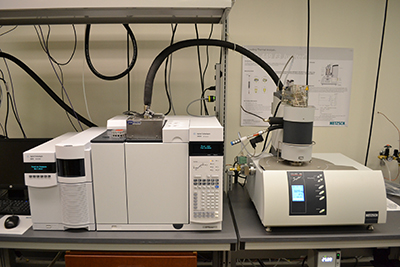
Netzsch’s Simultaneous Thermal Analysis (STA) system allows the measurement of mass changes and thermal effects between -170°C and 1600°C. This instrument can perform simultaneously Differential Thermal (DTA) and ThermoGravimetric (TGA) analyses, or Differential Scanning Calorimetry (DSC) and TGA. Thermal events, such as materials’ decomposition and phase transitions, can be quantified. A wide range of applications from polymer identification to heat capacity measurements are possible. Furthermore, the furnace of the STA is coupled to a GC-MS and/or FT-IR where the mass of any volatile fragments can be analyzed and identified.
Capabilities
- ThermoGravimetric analysis (TGA) with sensitivity of 1μg up to 1600°C
- Simultaneous Differential Scanning Calorimetry (DSC) and TGA (-170°C to 700°C)
- Simultaneous Differential Thermal Analysis (DTA) and TGA (0°C to 1600°C)
TA DSC
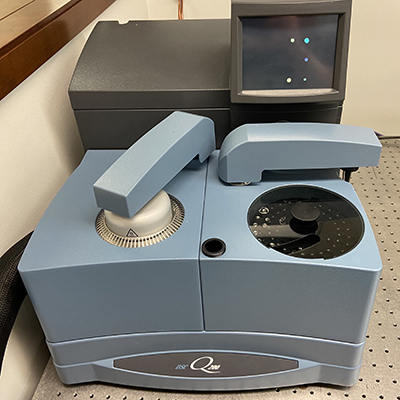
TA’s high throughput Differential Scanning Calorimetry (DSC) instrument allows the measurement of thermal events between -90°C and 500°C. Thermal events such as glass transitions, melting points, crystallizations, phase transitions, and phase changes can be measured. A wide range of applications from polymer identification to heat capacity measurements are possible. With the help of the autosampler, up to 50 samples can be loaded and measured one-by-one under different conditions.
Capabilities
- Differential Scanning Calorimetry (DSC) (-90°C to 500°C)
- High throughput, up to 50 samples
- Measurement of solid and liquid samples
Xenemetrix ED-XRF
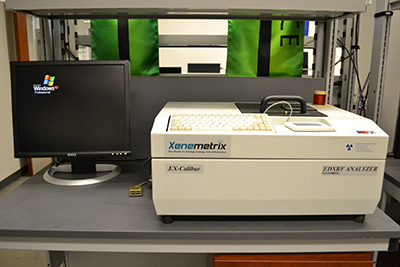
Xenemetrix’s ED-XRF can be used for non-destructive elemental analysis at qualitative, semi- quantitative (ratios), and quantitative levels. Sample preparation is minimal and analysis can be performed in a variety of materials’ form, such as solids, powders, liquids, thin films, etc. ED-XRF can quantify any element that is heavier than sodium and lighter than uranium. This analytical technique can cover a broad concentration range from ppm to 100% with a simultaneous analysis of many elements.
Capabilities
- Non-destructive (semi-)quantitative elemental analysis (from Na to U)
- Minimal sample preparation. Works on solids, powders, liquids, and thin films
- Broad concentration range from ppm up to 100%
- High throughput up to 8 samples
- Quick and simultaneous qualitative analysis for most elements in the periodic table
Bruker Tensor 37 FTIR (MiD IR / ATR)
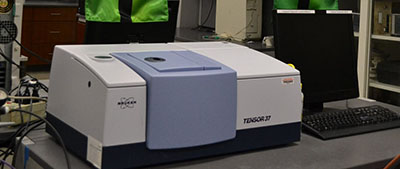
The Bruker Tensor 37 FTIR Spectrometer is equipped with an Mid IR detector and KBr beamsplitter for use between 400 and 7000 cm -1 . Sample can be analyzed using the ATR attachment, a gas cell or by pressing KBr pellets. In addition to the Bruker software a ~50,000 sample library aids in the interpretation of spectra and identification of unknowns.
Capabilities
- Spectral Range from 7500 to 370 cm -1
- Resolution better than 0.6 cm -1
- Wavenumber accuracy better than 0.01 cm -1 at 2000 cm -1
- Photometric accuracy better than 0.1 % T
- Signal to noise (Minimum): 5 Sec: > 6000:1 (= < 7.2*10 -5 AU noise) peak to peak, 4 cm -1 resolution
- Scan Speed: 5 velocities, 2.2 – 40 Hz (1.4 – 25.5 mm/sec opd)
AUTOPOL VI Polarimeter
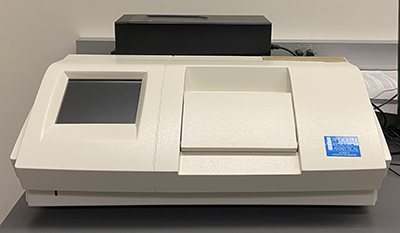
Rudolph Research Analytical's automatic microprocessor based polarimeter for measuring optical rotation. The Autopol VI has temperature control from 15-40 C and measures optical rotation at 365 nm, 405 nm, 436 nm, 546 nm, 589 nm and 633 nm.
Capabilities
- 0.0003 accuracy for low rotation samples of ±1° Arc
- Electronic cooling and heating from 15°–40°C
- Six Standard Wavelengths: 365 nm, 405 nm, 436 nm, 546 nm, 589 nm, 633 nm
Microbalances
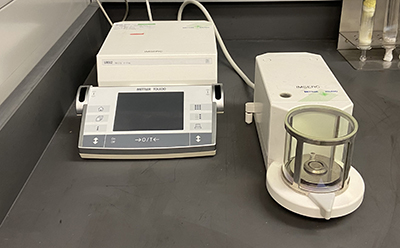
Precise balances for weighing very small samples with a high degree of accuracy. We have two microbalances with 1 μm and 0.1 μm accuracy, respectively.
Capabilities
- 0.1 μm accuracy with maximum mass of 2.1 g
- 1 μm accuracy with maximum mass of 5.1 g
Karl-Fischer Coulometer
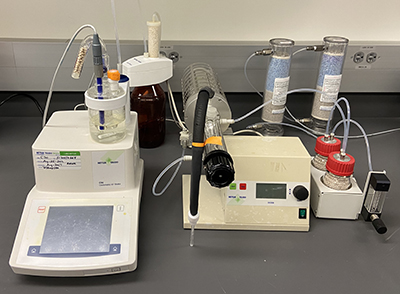
The Mettler-Toledo C30 titrator is equipped with a coulometric cell filled with a methanol-based electrolyte. Coulometer can quantify traces of water at ppm-levels, in liquids or solid samples. In addition, the coulometer has a furnace for quantifying water in solid samples that are not directly soluble by the methanol-based electrolyte.
Capabilities
- Quantify ppm-level of water in either liquid or solid samples
- Furnace for removing water in solids that are not soluble in a methanol-based electrolyte
Cary 5000 UV-Vis-NIR Spectrophotometer
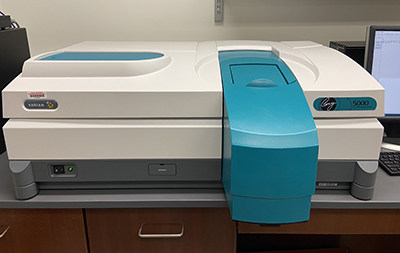
The Cary 5000 UV-Vis-NIR Spectrophotometer is equipped with various light sources and detectors for use between 175 and 3300 nm. Solid powder samples can be analyzed using the Diffuse Reflectance attachment, liquids using standard cuvette holders, and translucent solids or thin films using the flat-plate transmission attachment. Variable temperature measurements of translucent solids or thin films are available in the temperature range of -25 C to 120 C.
Capabilities
- Spectral Range from 175 to 3300 nm
- Powder samples using diffuse reflectance
- Liquids in cuvettes
- Thin films in transmission (temperature range of -25 C to 120 C)
- Translucent bulk solids in transmission (temperature range of -25 C to 120 C)
- Relative specular reflectance of a sample surface at angles of incidence between 20 to 70 degrees (refractive index determination)